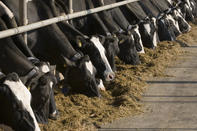To increase milk yield, a supplementary concentrate mixture is fed, usually at the time of milking. The concentrate supplement is fed individually to cows. The amount cows are fed depends on their breed, their milk yield or stage of lactation. Concentrates can be fed according to a flat-rate feeding system or a step-rate feeding.

A flat-rate feeding system feeds a fixed amount every day from calving to the end of the lactation period. For example a Holstein will require 9 kg/day for the duration of the period. A step-rate feeding system will feed different amounts of feed for the different lactation stages.
For example 12 kg/day from calving to 100 days in milk (DIM), the 9 kg/day from 101-200 DIM and then 6 kg/day from 201 DIM to drying off. Similar amounts of concentrate can be fed to cows being fed different forages; however, the protein and energy content of the concentrates will differ. For example, concentrate given to cows on pastures will contribute energy and minerals, while concentrate given to cows on oat hay should have a protein content of around 19%.
In spite of feeding high-quality forage and a high concentrate level of 12 kg/day during early lactation, energy intake is often insufficient. This may result in cows using body reserves (fat) to produce milk and can cause cows to lose weight.
During mid-lactation (101-200 DIM) the milk yield and body condition of cows should be maintained. In late-lactation, milk yield declines and cows go into a positive energy balance. The body condition of cows will improve resulting in showing an increase in live weight. In essence, it means that fat cows cost money.
Feeding of Dry Dairy Cows
Cows are dried off 50-60 days before the next calving date. The dry (non-lactating) period is essential for the recovery of the milk-secreting cells in the udder. Dry cows are fed separately from other cows because of their lower feeding requirements.
They should not become too fat as this is costly but can also cause problems like ketosis after calving. Concentrates should not be fed at too high levels as this increases feeding costs while also replacing lower cost forages.
The response in milk yield decreases at higher concentrate levels. This is referred to as the law of diminishing returns. For example feeding 0 - 4 kg of concentrate will yield a milk response of 0.72 kg per kg of concentrate, but feeding 4 - 8 kg of concentrate will only lead to a response of 0.35kg increase in milk. So, do not feed high levels of concentrates as the milk yield response decreases.